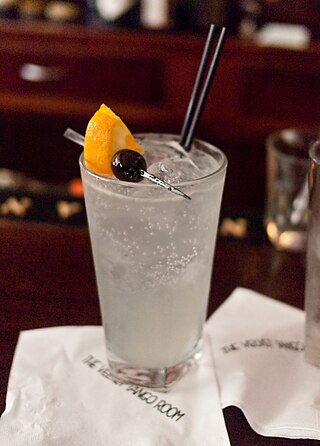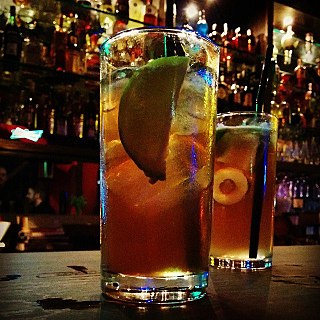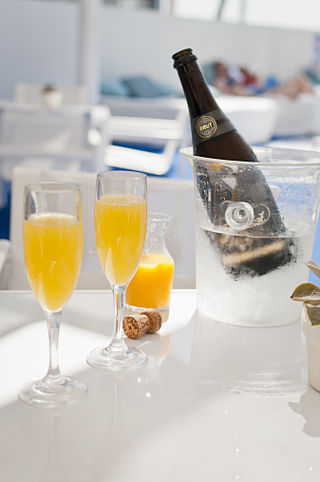
The Tom Collins is a Collins cocktail made from gin, lemon juice, sugar, and carbonated water. First memorialized in writing in 1876 by Jerry Thomas, "the father of American mixology", this "gin and sparkling lemonade" drink is typically served in a Collins glass over ice. A non-alcoholic "Collins mix" mixer is produced, enjoyed by some as a soft drink.

The Long Island iced tea, or Long Island ice tea, is an IBA official cocktail, typically made with vodka, tequila, light rum, triple sec, gin, and a splash of cola. Despite its name, the cocktail does not typically contain iced tea, but is named for having the same amber hue as iced tea.

A margarita is a cocktail consisting of tequila, triple sec, and lime juice. Some margarita recipes include simple syrup as well and are often served with salt on the rim of the glass. Margaritas can be served either shaken with ice, without ice, or blended with ice. Most bars serve margaritas in a stepped-diameter variant of a cocktail glass or champagne coupe called a margarita glass. The margarita is one of the world's most popular cocktails and the most popular tequila-based cocktail.

The martini is a cocktail made with gin and vermouth, and garnished with an olive or a lemon twist. Over the years, the martini has become one of the best-known mixed alcoholic beverages. A popular variation, the vodka martini, uses vodka instead of gin for the cocktail's base spirit.

A shooter, or shot, is a small serving of spirits or a mixed drink, typically consumed quickly, often in a single gulp. It is common to serve a shooter as a "side" to a larger drink.

Cocktail garnishes are decorative ornaments that add character or style to a mixed drink, most notably to cocktails.
The brandy daisy is a cocktail which first gained popularity in the late 19th century. One of the earliest known recipes was published in 1876 in the second edition of Jerry Thomas's The Bartenders Guide or How To Mix Drinks: The Bon-Vivants Companion:
Fill glass half full of shaved ice. Shake well and strain into a glass, and fill up with Seltzer water from a syphon.

A "fizz" is a mixed drink variation on the older sours family of cocktail. Its defining features are an acidic juice and carbonated water. It typically includes gin or rum as its alcoholic ingredient.

A sea breeze is a cocktail containing vodka with cranberry juice and grapefruit juice. The cocktail is usually consumed during summer months. The drink may be shaken in order to create a foamy surface. It is considered an IBA Official Cocktail.

The Cape Cod or Cape Codder is a type of cocktail consisting of vodka and cranberry juice. Some recipes also call for squeezing a lime wedge over the glass and dropping it into the drink. The name refers to Cape Cod, Massachusetts, a peninsula and popular tourist destination located in the eastern United States which is famous for growing cranberries.

A woo woo is an alcoholic beverage made of vodka, peach schnapps, and cranberry juice. It is typically served as a cocktail in a highball glass or can be served as a shot. It can also be served in a rocks glass. The ingredients are usually shaken together with ice or stirred as preferred. A lime wedge is used as a garnish.

A Bloody Mary is a cocktail containing vodka, tomato juice, and other spices and flavorings including Worcestershire sauce, hot sauces, garlic, herbs, horseradish, celery, olives, pickled vegetables, salt, black pepper, lemon juice, lime juice and celery salt. Some versions of the drink, such as the "surf 'n turf" Bloody Mary, include shrimp and bacon as garnishes. In the United States, it is usually consumed in the morning or early afternoon, and is popular as a hangover cure.

The aviation is a cocktail made with gin, maraschino liqueur, crème de violette and lemon juice. Some recipes omit the crème de violette. It is served straight up, in a cocktail glass.

A mimosa cocktail consists of champagne and chilled citrus juice, usually orange juice. It is often served in a tall champagne flute at festive occasions such as brunch, weddings, or as part of business or first class service on some passenger railways and airlines. The mixing ratio varies.
The Mexican martini is a cocktail variation of a Margarita served straight up in a cocktail glass like a Martini. It is a popular drink in Austin, Texas.

A lemon drop is a vodka-based cocktail that has a lemony, sweet and sour flavor, prepared using vodka, triple sec, and fresh lemon juice. It has been described as a variant of, or as "a take on", the vodka martini, but is in fact closer to a white lady variant. It is typically prepared and served straight up – chilled with ice and strained.
The test pilot cocktail is a vintage tiki drink invented by Donn Beach. Beach was known for changing his recipes over time, and multiple versions of the test pilot attributed to both him and others make the cocktail one of his more frequently imitated and varied tiki drinks. Test pilot recipes call for multiple rums and typically include the use of falernum syrup and lime juice. The more popular also include Pernod (pastis/absinthe) and bitters.
The Trumptini is a cold, cranberry-flavoured cocktail made with Bacardi Limon, Cointreau, sour mix and cranberry juice. It is traditionally served in a Rokz salt-rimmed martini glass, and garnished with scoop of premium red Atlantic salmon caviar, and a T-shaped slice of lemon peel.
















